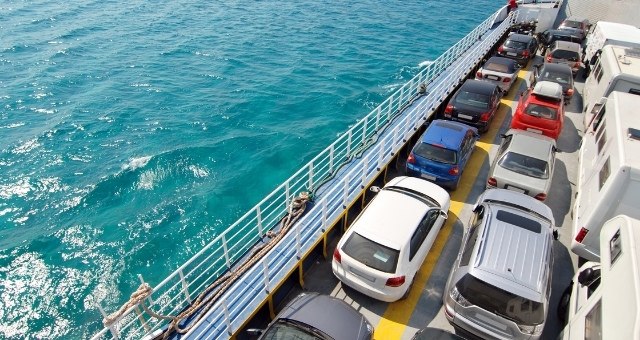Driving in the Greek islands: ultimate guide for a smooth ride
Where goats are your archenemy!Have you ever dreamed of driving in Santorini with a view to the caldera, boarding the ferry with your car at Piraeus Port, exploring the mountain villages of Crete, or going on a road trip through lush forests in Corfu? Getting around by car in the Greek islands is a wonderful experience that fills you with sweet memories and a feeling of… "IS THAT A GOAT IN THE MIDDLE OF THE ROAD"?
Read our guide about driving in Greece, to enjoy your trip to the Greek islands with no surprises! Get familiar with basic Greek road rules and find useful tips about getting around by car or motorcycle, from boarding the ferry to exploring the most remote beaches.

Enjoying the view during a road trip in Milos
Greek road rules for cars and motorcycles
Driving in Greece for first-timers might seem a bit intimidating, but no worries! Once you get the hang of it and get acquainted with some basic road rules for driving in Greece, you will surely enjoy the experience!
The vast majority of road signs are in Greek and English (at least in urban or popular areas). Make sure you follow the driving regulations below, bring along a good playlist with your favorite relaxing tunes, and hit the road!
Here are 11 important Greek driving regulations you need to know:
- Driving is on the right-hand side of the road in Greece.
- All car passengers are required to wear seatbelts, while motorcycle riders need to wear a helmet.
- The minimum age limit to drive a car in Greece is 18 years old.
- If you have already entered a roundabout, you need to stop and give way to traffic entering the roundabout.
- Using a mobile phone for calls without hands-free or bluetooth is forbidden in Greece. Texting while driving is definitely prohibited, but you already know this!
- Speed limits for cars and motorcycles are 50 km/h on urban roads, 90 km/h on non-urban roads and 110-130 km/h on motorways. Make sure you follow speed limits as indicated on road signs.
- You are required to have the following pieces of safety equipment in your vehicle: warning triangle, first-aid kit and fire extinguisher.
- EU driving license holders can drive freely in Greece. The same is true for UK, US and Australia driving license holders, as well as some other countries. In some cases, if your license is issued from a country outside of the EU, you may need to get an international driver’s license/permit before your visit.
- The maximum blood alcohol content is set at 0,5 g/l for standard drivers (around a pint of beer). There are different regulations for new drivers and professionals.
- Child seats are mandatory for children up to 4 years old. Moreover, children under 10 years of age should not travel in the front seat.
- Vehicles may be towed away if parked illegally, so pay attention to road signs and do not park close to accessibility ramps, traffic lights and pedestrian crossings. Yellow lines on the curbside indicate that it’s illegal to park or stop.
Tip: have a look at Matt Barrett’s guide on driving in Greece for more useful tips and get acquainted with all road safety rules for Greece on the European Commission website.

Cars by the Temple of Olympian Zeus in the city center of Athens
Boarding the ferry with a car in Greece
Bringing a car or motorcycle on the ferry is a great idea to explore many of the Greek islands. Driving your own vehicle gives you peace of mind when arranging your trip. You can easily travel to some of the best beaches in the Greek islands, explore secluded villages and get around flexibly at night.
Good to know: it’s good to bear in mind that there's not always public transport on smaller islands and remote villages.
To bring a vehicle on the ferry car deck you need to get a ferry ticket. You can book your car ticket in advance on Ferryhopper. As car deck spaces sell out fast, we recommend you book at least 3 months in advance, particularly for popular ferry routes. You can check all ferry ticket offers for 2023 on Ferryhopper to book the cheapest vehicle ferry tickets.
The most important thing to remember when boarding a ferry in Greece with your car or motorcycle is to follow the ferry car deck steward guidelines. They will guide you through the process of boarding the ferry through the car deck door and guide you to the proper parking spot on board.
You may need to do one or two intricate manoeuvres to perfectly fit your car on board and it can feel a bit overwhelming at first with all the noise and traffic, but you’ll be fine, you Master of Tetris!
Tip: find more information on what you need to do if you’re thinking of transferring an unaccompanied vehicle by ferry in Greece.
Good to know: bear in mind that although most ferries can accommodate cars, motorcycles and more vehicles, this is not the case for all vessel types. For example, smaller ferries operating on local routes or smaller high-speed vessels do not always have car decks.

Cars on a ferry traveling to the Greek islands
Tips for driving in the Greek islands
The same driving regulations apply both for mainland Greece and the islands. That being said, the driving situation in the Greek islands is a social phenomenon of its own!
Particularly during peak season, the Greek islands welcome visitors from all over the world. This melting pot of islanders and travelers is never boring! We recommend that you always follow the Greek driving regulations and be extra vigilant on the road, especially at night.
Here’s a list of 5 tips to help you have a smooth driving experience in the Greek islands.
- If you get lost, you can always ask a local for directions. Most of the islanders speak enough English to help you get around. If that fails, body language is the way to go!
- Bear in mind that online maps are not always accurate for the Greek islands. There might be extra roads or some options that are no longer available! Also, GPS signal is not always good on remote islands, but you’ll be fine in popular destinations such as Mykonos and Santorini.
- Goats and other domestic, farm or wild animals, such as cats, sheep and donkeys, are common traffic crashers in the Greek islands, but no need to panic. You just need to wait until they’re off the middle of the road and proceed with caution. Most of them are friendly and cute, so you might even be able to take a nice photo to share online while you’re waiting.
- Most islands have car rental sites, but cars and motorcycles sell out really fast. Ferryhopper suggests that you book online before your trip.
- If there are no road signs and you feel unsure whether you need to give way, do give way. Better be safe than sorry!
Good to know: most rental car companies require drivers to be at least 21 years old and have had a drivers license for 1 year or more to be able to rent a car.

“Beware of the goats” road sign in Samothrace
Now that you’re an expert on driving in the Greek islands, it’s time to book your ferry tickets to your dream destination on Ferryhopper and plan your road trip in Greece.
Don’t forget to rent a car for your trip in Greece in advance to find the best prices! Ready, set, go!